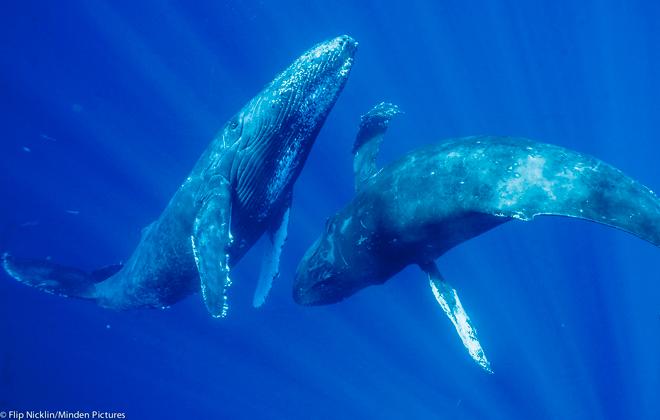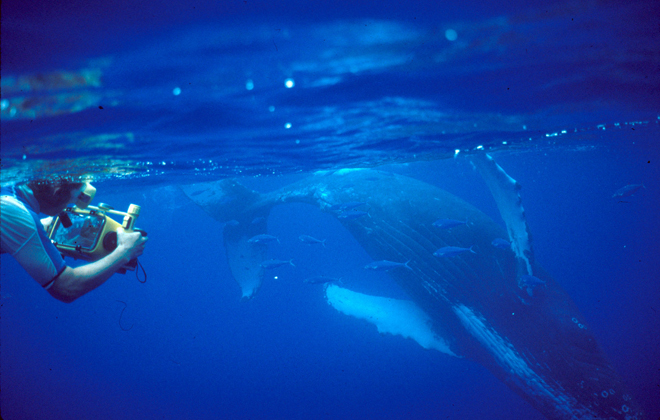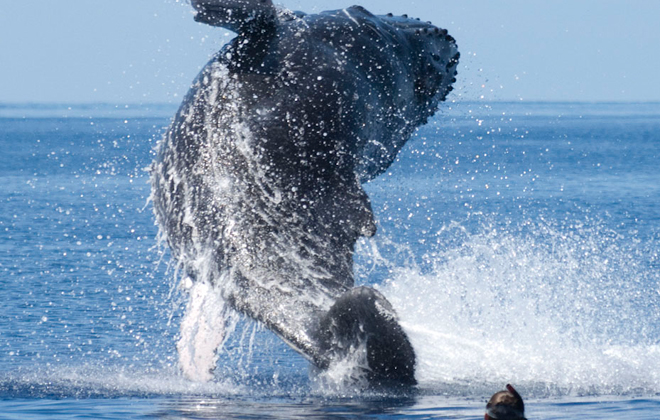Perhaps it’s the way he courts her with song, or his displays of strength to impress her with his enormous size. And when she extends a pectoral fin to almost touch him, is she flirting?
The intricacies of Hawaiian humpback whale courtship and mating remain a mystery, even after years of study by marine scientists seeking to understand the endangered species.
"Here in Hawaii, everything is about reproduction," said researcher Meagan Jones of Whale Trust Maui, an international nonprofit. "And so everything we’re studying here is related to reproduction in some way, which is, of course, critical to their survival. The more we understand about what is required for successful reproduction to occur, the more effective we can be in managing whale populations."
After more than 35 years of research, no scientist has ever witnessed or documented the mating act between humpback whales in Hawaii or elsewhere.
"Nobody’s seen it," said Adam Pack, an assistant professor of biology at the University of Hawaii at Hilo. "In addition to hoping one might see it, we’re still trying to understand the larger dynamics of the mating system."
Peak whale season in Hawaii takes place between January and March, when an estimated 10,000 whales migrate from Alaska to Hawaii to mate and give birth, generating an estimated $20 million for the state’s whale-watching industry. The first sighting this season came early, in mid-September off west Kauai.
|
WHERE TO SEE HUMPBACK WHALES Federal regulations require maintaining a distance of 100 yards when encountering whales in or on the water; aircraft stay 1,000 feet away. To report entangled or distressed whales, call NOAA Fisheries’ hotline at 888-256-9840.
50 years
Approximate lifespan
Source: NOAA
Up to 60 feet
Length of an adult
25 to 40 tons
Weight of an adult humpback whale
2,000 pounds
Weight of newborn calf
|
With its warm, clear waters, Hawaii’s Humpback Whale National Marine Sanctuary, centered mostly around the four islands of Maui County, is an ideal laboratory for scientific observation of humpback whales. A core group of about 10 to 12 scientists seek federal and state permits each year to conduct long-term research in sanctuary waters. As of Jan. 13, the state had issued seven permits, to Whale Trust and the Pacific Whale Foundation, among others, and was processing four more for this season.
Research indicates that females, with or without calves, are almost always accompanied by a male who is not the father, but scientists aren’t sure why. These male escorts are known to compete aggressively for a female’s attention.
Female humpback whales endure an 11-month gestation period and then spend up to a year raising their offspring. They are understandably choosy when it comes to picking a mating partner, according to Pack, preferring males exhibiting traits most likely to improve the chances of their calves’ survival.
"They really want to pair with the largest adult males," he said.
The males, who split after the deed is done, can be discriminating about size as well, Pack said, but not as much.
Whale researchers have determined that only male humpbacks sing, but are still uncertain whether the behavior plays a role in mating or attracting females.
Pioneering whale researcher Louis Herman, along with Pack and their research team from The Dolphin Institute, in 2013 published a paper concluding that both juvenile and sexually mature males sing while in the Hawaiian breeding grounds.
"Apparently, it’s a lifetime occupation," said Herman, professor emeritus at the University of Hawaii. "Each year we record songs but don’t necessarily see the same singers every year. However, we’ve recorded some individuals singing over intervals of 20 to 30 years, though we don’t know what’s happening with them in between those years."
The juveniles could be joining in to be part of the group, but more likely they’re learning and practicing skills that will give them mating success in later years, Herman said.
This year, the team will for the first time collaborate with researcher Shannon Atkinson in Alaska, using body size data and small skin biopsy samples to understand exactly when females become receptive to suitors during their journey south to Hawaii. The samples are obtained by firing a small dart at the side of the whale to extract about a half-centimeter of skin and blubber. The dart bounces off and floats in the water until recovered by the team.
When Herman first began studying whales in 1976, his team was the first to use aerial and boat-based surveys.
Today, digital video, remote acoustic technology and unmanned ocean robots have opened new doors for scientists, allowing them, for instance, to measure the body size of humpback whales using a technique called videogrammetry.
Researchers in mask, snorkel and fins ease into the water, carrying a digital video camera in an underwater housing and a hand-held sonar device. Later, they can determine the whale’s length based on the images taken at a specific angle and distance measured by sonar.
Most of the focus is on what happens below the surface, where whales spend 90 percent of their time.
In 2005, Herman partnered with National Geographic to install Crittercams on whales to observe their behavior underwater. Researchers’ latest methods include using tags, attached to the whales with suction cups, that provide video, audio and other data such as depth, speed and movements below the surface.
Jessica Chen, a student working for the Hawaii Institute of Marine Biology, will use the tags this season, along with underwater microphones to examine how mothers and calves communicate with each another.
Bruce Mate, a pioneer in satellite telemetry (using miniature radio tags), will join researchers this year with a new project following the whales’ migration routes to Hawaiian waters.
Every new discovery yields another piece of the puzzle of humpback whale mating.
Jones of Whale Trust Maui, with principal investigator Jim Darling and photographer Flip Nicklin, once witnessed what looked like a dance of courtship among a whale pair, only to find out that both were males.
While females without calves are coveted by males because they are more likely to be open to mating, females with calves also attract escorts who accompany them, perhaps looking to be ready for the next mating opportunity.
"It’s been a bit of a conundrum to figure out why they (female whales) would be hanging out with other males," Jones said. "Everyone kind of agrees males are associating in hopes they get to mate with her. How often she does that is a whole different question."
But females with calves are not as interested, according to Jones’ most recent study, which will soon be published. When playing back sounds of male whales in the breeding grounds, females with calves tended to travel quickly in the opposite direction.
The team monitored the mothers’ speed of travel and movement patterns and is exploring when the animal would be most receptive to advances based on her reproductive status.
They also will continue to focus on the role of whale songs in mating. The presumed courting song is evolving, according to researchers. The team is comparing songs in Hawaii with those in the Philippines, Japan and Mexico.
Perhaps, one day, someone will witness the whales in the act of breeding.
"I think it’s gotta be a stroke of luck," Herman said. "You have to be there, wherever and whenever they’re mating. We don’t know where it occurs beyond somewhere in the wintering grounds, and it may be brief. They may mate in remote locations, or perhaps deep underwater, or even during migration to or from the winter grounds. We just don’t know."
|
WHALE EVENTS
>> Run & Walk for the Whales. Join the Pacific Whale Foundation for its annual Run & Walk for the Whales, Jan. 31 at Ma‘alaea Harbor Shops, Maui. Events include a half marathon, 5K and 10K runs, and 2.5-mile walk. Entry fee $30 to $65 (before Jan. 29). All proceeds support the foundation. Call 249-8811, ext. 1 or register at flpregister.com/101.
>> Whale Sanctuary Ocean Count. Held from 8 a.m. to 12:15 p.m. Jan. 31, Feb. 28 and March 28. Volunteers are needed to count humpback whales and record behaviors in the waters off Oahu, Kauai and Hawaii island. A list of Oahu sites is available at goo.gl/HIQvGs. Call 725-5923 or visit goo.gl/Cmz7.
>> World Whale Day. Pacific Whale Foundation hosts an all-day celebration on Maui of humpback whales starting at 9 a.m. Feb. 14 with Parade of Whales down South Kihei Road to Kalama Park. Includes entertainment, hula, whale-themed attractions and keiki carnival. Admission is free. Call 249-8811, ext. 1 or visit www.mauiwhalefestival.org.
>> Trail of the Whale: Maui whale-watchers will find Pacific Whale Foundation naturalists sharing information at four stations along the coast. Get stamps at each station and bring the completed Trail of the Whale certificate to the foundation’s Ocean Store, 612 Front St. in Lahaina, or at Ma‘alaea Harbor Shops to receive a prize. Visit www.pacificwhale.org.
>> Whale Tales 2015. Whale Trust Maui hosts top international whale researchers for talks about critical issues in whale research, Feb. 13-16. Speakers include Bruce Mate, a pioneer in satellite tagging of whales and migration patterns; Ken Balcomb, an authority on underwater sonar testing impacts on whales; and Marc Lammers, who uses remote acoustic technology to monitor and track cetacean populations in Hawaii and around the globe. Other events include National Geographic contributing photographer Flip Nicklin and underwater cinematographer Jason Sturgis presenting some of their favorite underwater footage, whale-watch excursions, and a behind-the-scenes preview of the new IMAX movie “Humpback Whales 3D.” Proceeds support whale research on Maui. For information, call 572-5700 or visit WhaleTrust.org Opens in a new tab.
|










